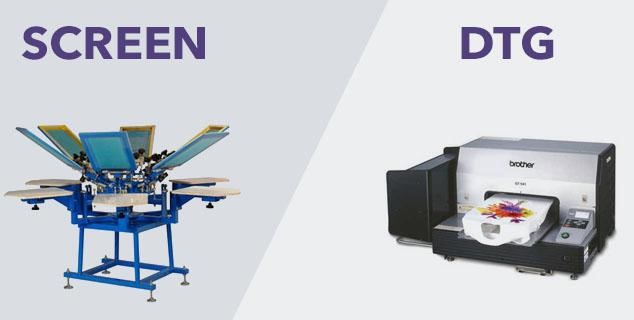If you’re looking to design and print your customized t-shirts, you’ve likely encountered the two printing methods – screenprinting and digital printing, also known as direct to garment printing method (DTG). Both screenprinting and digital printing methods are methods used to print designs onto fabrics.
What’s the difference between the two methods, and which technique is right for your project? The topic may be confusing if you’ve never dealt with either of the methods before. This guide will answer all the questions you may have about screenprinting and digital printing. Whether you’re creating custom t-shirts for a creative project, a campaign, promotion, or a fundraising campaign, understanding the printing process will help you make the best choice for your project.
What’s screenprinting?
Screenprinting is an art that printers have perfected over the years to produce beautiful and attractive, durable designs. Even though screenprinting is a more labor-intensive process, it makes vibrant, saturated colors and a unique, authentic look.
How does it work?
Screenprinting is a procedure where ink is pressed through a stencil made of mesh onto the fabric. Every color used in the design is printed separately using a different screen. This means that the printers must break down your design into different layers, depending on the number of colors that need to be printed. You can use simple design software like Illustrator or Adobe Photoshop.
Next, a stencil is used to apply one color ink at a time. This means that for every color, there’s a different stencil used. The ink is then pulled across the stencil using a foam tool or a blade where a single layer of the design is produced with full, saturated color.
Benefits of screenprinting
Vibrant designs
Screenprinting produces vibrant and bolder colors that may be challenging to replicate with other printing methods. Digital printing uses thinner inks like cyan, magenta, yellow, and black (CMYK) dots to make images. While it’s amazing in detail, results appear paler when compared to screenprinting.
Speed and efficiency
Screenprinting is considered fast and efficient because once the screen is made, the printing process is faster. Some screenprinting machines work fast and can print over 4,000 t-shirts per hour.
Excellent for bulk orders
If you want to print bulk orders, then this is the right process for you. The more you order, the less you pay per item because the amount used to set up the screens and the entire printing process is reduced with a larger order volume. Plus, screenprinting is excellent if you need the same design printed on different t-shirts, models, or sizes. Place your bulk order today here.
Variety
There are various types of inks you can use to create different effects and textures with screenprinting. Some printing machines can also work with large screen surfaces to produce even more customized designs. Here’s where you can be as creative as you want because the possibilities are endless with screenprinting; you can use any color and apply any finishes that suit your design.
High color quality
The consistency of the inks used in screenprinting produces better, brighter, and vibrant colors.
Durable
Due to the composition of the inks used in screenprinting, designs made with these methods can withstand more stress than those printed with other techniques, without losing their image quality and color.
Versatile
It’s challenging to find a printing method as versatile as screenprinting. This is because screenprinting can be done on any surface (wood, metal, fabric, plastic, etc.) as long as the surface is flat.
It’s a straightforward process
Screenprinting is a simple process that’s the same, even if you’re using a manual or an automated printing process. The tools used are also not hard to replace, and won’t become obsolete as fast as we’ve seen other technologies in the printing industry.
Disadvantages of screenprinting
High setup costs
You’ll realize that the time spent printing is much less than the time spent creating the screens and preparing the designs. The preparation process, unfortunately, creates high setup costs and mostly if you have low order volumes. Essentially, the price per item will be higher when ordering in low quantities, so sometimes, printers set a minimum number of orders one can order for screenprinting. For bulk orders, the setup costs even out within the cost per item.
Unsustainable
Although modern advancements have been made to create eco-friendly screens and ink, the amount of water used to clean the screens and designs after printing can be a lot and is mostly wasted. If a facility doesn’t put a recyclable water process in place since they produce thousands of prints per day, they may be wasting thousands of liters of water per day.
Limited colors
When you have to create a different screen for different colors, it complicates the process and makes it even more costly. It works with designs that use fewer colors and designs that aren’t as complex. Choosing screenprinting for your project won’t be realistic if you seek to print photo-realistic images on fabric. With screenprinting, it’s hard to replicate all the colors and details present in photos, e.g., landscapes. For photo-realistic images, you may want to choose another printing technique like digital printing.
What’s digital printing/direct to garment printing?
Digital printing is a process where digital textile printers use advanced technologies to print images on fabric, the same way as your printer at home prints images on paper. The whole process starts when the fabric to be printed is selected, pre-treated, and passed through the digital printer at high speed. The design is then transferred onto the fabric and steamed, washed to remove excess dye and treatment used on the fabric before printing, and then, it’s dried.
Instead of pressing the various pre-mixed inks on the fabric through screens, as with screenprinting, digital printing uses a printable image or design of a graphical data file. Then, it reads the right color information using the RGB system or LAB system and then prints the chosen color onto the garment using tiny droplets of ink.
What are the advantages of digital printing?
Digital printing is a recent textile printing method and has its unique advantages; for example, if you want to print an image of your adorable pet dog printed into a purse, you probably need to use it for photographic accuracy. DTG printers like the Epson F2100 are an excellent option due to their extreme print quality, fast print speeds, and industrial-grade reliability. Additional benefits of this printing method include:
Speed
Digital textile printing is a faster process and can handle rush orders. All the printer needs are the design images, printed directly onto the fabric or garment. Even if you’re not working on a tight deadline, the process eliminates a lot of waiting time compared to screenprinting.
Quantity
With digital printing, you can order small quantity orders, while screenprinting usually has a minimum quantity set that can be printed. For example, if you want to print a few t-shirts, let’s say for a baby shower party, it would be best to choose the digital printing method because it will be cheaper.
Price
Digital printing doesn’t involve any steps or complex preparation techniques as with screenprinting, where you have to create screens before printing. The printer only needs the image and a substrate, and you’re good to go. The minimal setup time and less equipment required means that the process will cost less than screenprinting.
Flexibility
Digital printing offers greater variability without increasing costs or production time. If you need to print the same design with multiple captions, this kind of design would cost more if you use screenprinting, but with digital printing, it’s merely a Photoshop manipulation.
Detailing
When you use digital printing, you can recreate small intricate details on the garment because it’s extremely precise. This means that digital printing is the ideal method to use when you want to print sharp photographic designs or other complex images and artwork.
Eco-friendly
The entire process of digital printing doesn’t require a lot of equipment, chemicals, or materials. There’s less wastage, and you don’t have to worry about any chemical disposals.
Disadvantages
- The range of fabrics you can print with digital printing is limited compared to screenprinting.
- The print isn’t durable and may fade after several washes. This is because the ink doesn’t penetrate the fabric’s fibers, and the design stays on the surface of the material.
- The ink used on digital printing doesn’t penetrate the fabric, and that’s why it can’t be used to print dark colors.
- The colors don’t appear as bold and textured as with screenprinting.
Conclusion
It all depends on the project you have, and that’s what will determine the method of printing you choose. Each method has its pros and cons. The choice is yours to choose the best that suits your printing project.
Follow Technoroll for more informative articles.





